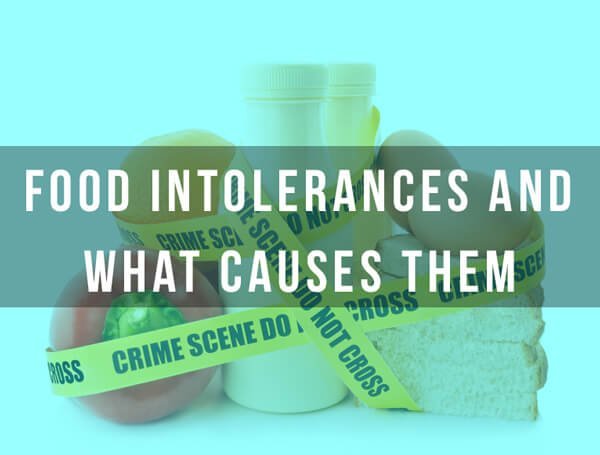My food intolerance list is as long as the one you go to buy groceries with and I can definitely attest to the fact that reacting to food sucks! Especially, if you aren’t sure what is causing it. Food intolerance and sensitivities can be tricky to navigate, so today I would like to show you how I treat them for myself and for my clients.
Food intolerance (also known as food sensitivity) is much more common than you think. Over 50% of the clients I see experience it to some degree, yet most don’t identify it as an intolerance, do anything about it or know what is causing it.
Not to be confused with food allergies (which involves the immune system), a food intolerance reaction occurs when an individual’s threshold to certain food components is exceeded. Symptoms can occur hours – even days – after eating the offending food. For example, I know I can tolerate a small amount of sucralose – but if I go above more than a serving or two I start holding water and getting bloated. Everyone is individual in how they respond to food with some reactions being less obviously related to food. Check out these surprising signs followed by common culprits to look out for.

8 Signs You Have a Food Intolerance
1. Your bathroom trips are unpredictable
I once had a client who wouldn’t take transit or attend an event where there may not be good bathrooms. This is quite a common mindset of someone with a strong food intolerance, as the most direct and immediate symptom is digestive stress. This includes things like severe abdominal pain, gas, bloating, and diarrhea. For some, these occasions get followed by a week of constipation before they are right back where they started.
2. Your head feels like its going to explode or like you cannot think clearly
Many are shocked when I tell them at ongoing headache may be a sign they are reacting to a food they consume. This is quite a common symptom of food intolerance, and largely avoidable when you know what the triggers are. This often is linked back to food additives and ingredients like MSG. It can also be a sign of leaky gut, with food components producing systemic reactions. Symptoms can take several hours before they hit.
3. Your joints hurt for no reason
Do you suffer from long-term muscle tenderness or joint pain that impacts your day-to-day activities? Joint pain is common as we age and if we are extremely physically active. Probably the most overlooked symptom that is triggered by foods we eat. In research, studies have found most patients with arthritis or fibromyalgia reported their symptoms worsened after eating certain foods. Discovering your own food sensitivities, and then cutting down or abstaining completely from those trigger foods, may be the most important thing you can do to treat this condition.
4. You feel like you could sleep forever despite getting enough hours at night
Chronic fatigue syndrome is the new buzz term everyone seems to be talking about in the health community. It is described as a disorder causing severe long-term fatigue that affects a person’s ability to carry out regular everyday activities. The cause like many other similar conditions is not well-understood. Food intolerance has long been suspected as a major trigger alongside genetics, inflammation, stress and more. Exploring the best form of treatment is an ongoing process, but diet is likely to play an influential role
5. You seem to be bloated no matter what you eat
Ever eat bread or wheat products only to have your stomach double in size? Have you gone to your doctor to ask for a Celiac test only for it to come back negative? It is thought that a large chunk of people who don’t have celiac disease still experience difficulties digesting gluten, a condition known as a Non-Celiac Gluten Sensitivity or Gluten Intolerance. While the mechanism is different to celiac disease, the symptoms are thought to be very similar. Aside from gluten, ingesting foods that you react too can cause an air balloon or water balloon effect to your digestive tract.
6. You get weird rashes or skin reactions
Hives reactions have always been linked to true food allergies. However, it is now well-understood that food intolerance can cause skin reactions too. Unlike allergies, this produces a much more delayed response. Remember that with food intolerance most can tolerate a reasonable amount of the food compound, but if they eat too much (or too often) then symptoms begin to show. Eczema, unusually dry rough patches of skin, acne flare-up can all be signs your body does not like what you ate.
7. You diet and train hard but the scale won’t budge
This is one that is all too common among people who plateau with their weight loss or fat loss goals. Even I have fallen prey to this sign without realizing there was something in my food I was reacting too. Water retention and inflammation can make it seem like you are heavier and larger than you really are. These symptoms can also make your body feel “unsafe” spiking your cortisol and making it harder to get results no matter your effort.
Top Food Intolerance Culprits
-
Wheat
– more than just the gluten component -
Yeast
– found primarily in bread, beer and other sneaky culprits like vinegar, soy sauce, pickles, cheese, and mushrooms -
Dairy
– primarily the lactose component that people react to, switching to lactose-free may be the fix for you -
Soy
– soy hides behind names like hydrolyzed vegetable protein (HVP), textured vegetable protein (TVP), lecithin, monodiglyceride, monosodium glutamate (MSG), vegetable oil, and vitamin E -
Egg
– a common cause of gas from many when eaten in isolation or in excess -
Corn
– found in many products but often not tolerated by many, reading labels are key -
Nightshades
– this category of vegetables includes tomatoes, potatoes, eggplants, tomatillos, and both sweet and hot peppers -
Onions & garlic
– some of the most common food triggers of digestive stress are onions and garlic. This is because they are so commonly used to add flavour, yet are also extremely high in FODMAPs. -
Artificial sweeteners, colours or additives like MSG
– in today’s food these are hard to avoid but could be the cause of your concern. Usually a dose response solved by eating more whole foods.
Anyone who is experiencing symptoms that they would describe as frequent, chronic, or daily should seriously consider whether the foods they eat frequently or daily may be contributing to the problem. Elimination style diet is a very effective way to tackle the issue. Book a free consultation with me to put together an easy-to-follow elimination diet and tackle your food intolerance once and for all.
About the Author: Ana Plenter

Ana Plenter is a an Award Winning Personal Trainer, Fitness Competitor & Competition Coach and the Founder of Build My Body Beautiful & Body Beautiful Fitness









